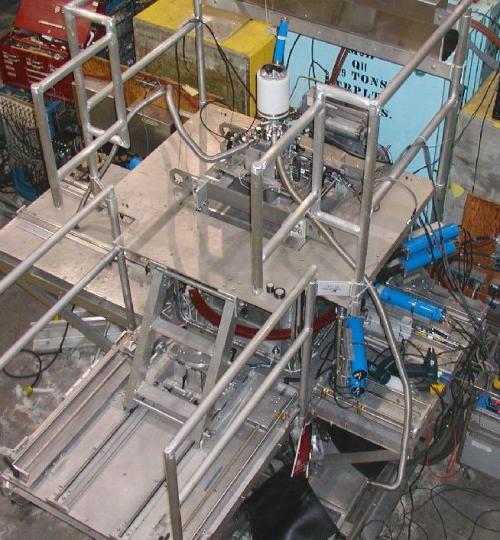Omni-Prime
Omni was so successful that there was demand for a copy of it, and less demand for an existing spectrometer named Eagle. Eagle was stripped of its main coils which were used to build another Omni apparatus, Omni', which was later rebuilt to its current configuration.
The main coils are spaced a generous 13.3 cm apart, providing 3.2 kG (0.32 T) axially with 750 A (4.25 G/A). There is a pair of Helmholtz coils for 150 G vertical field and saddle coils within the main magnet bore providing up to 200 G horizontal transverse field. Furthermore, there are axial shim coils for active feedback field control, as well as three-axis square coils for zeroing the field.
Several counter and sample-holder arrangements are possible using three side-tables and top platform. (The latter has easy access via a staircase.)
Vertical cryostat on top; F,B,R,L positron counters on side tables. Horizontal cryostat on (right) side; F,B,U,D positron counters (Forward, Backward, Up, Down) on (left) side table. Horizontal cryostat mounted axially; B,R,L positron counters on side tables. Horizontal cryostat mounted axially; B + axial counters. Large gas cell mounted axially; S-bent B + axial counters. The axial counters may be grouped and positioned to provide UR+UL+DR+DL or F or R+L.
Universal positioning platforms are present in each possible cryostat position, and the one on the top is motorized for remote position adjustment. Access to the sample region from the top measures 10 cm × 11.5 cm (axial × transverse); from the right access is through 13.3 × 18.8 cm (axial × vertical), some of which may be occupied by counters; axial access is 27 cm in diameter, or about 13.5 cm inside the axial counters.
Omni' is used exclusively for higher energy backward muons (on M9B). To this end it has a lead collimator wall, 3 inches thick, upstream of the coils, and two 1-inch copper collimator walls sliding on a track within the coils. This arrangement may need some explanation. For backward muons, it is desirable to use two muon counters, in coincidence, to avoid counting x-rays and positrons, and there should be collimation between the two counters so that they do not count decay positrons as beam muons. In the case of Omni', the first counter, M0, is inserted between the lead and copper walls while the second goes after all collimation, just before the sample. Note that all collimators take tungsten inserts to select the size of hole, though the holes in the upstream collimators should be larger.

